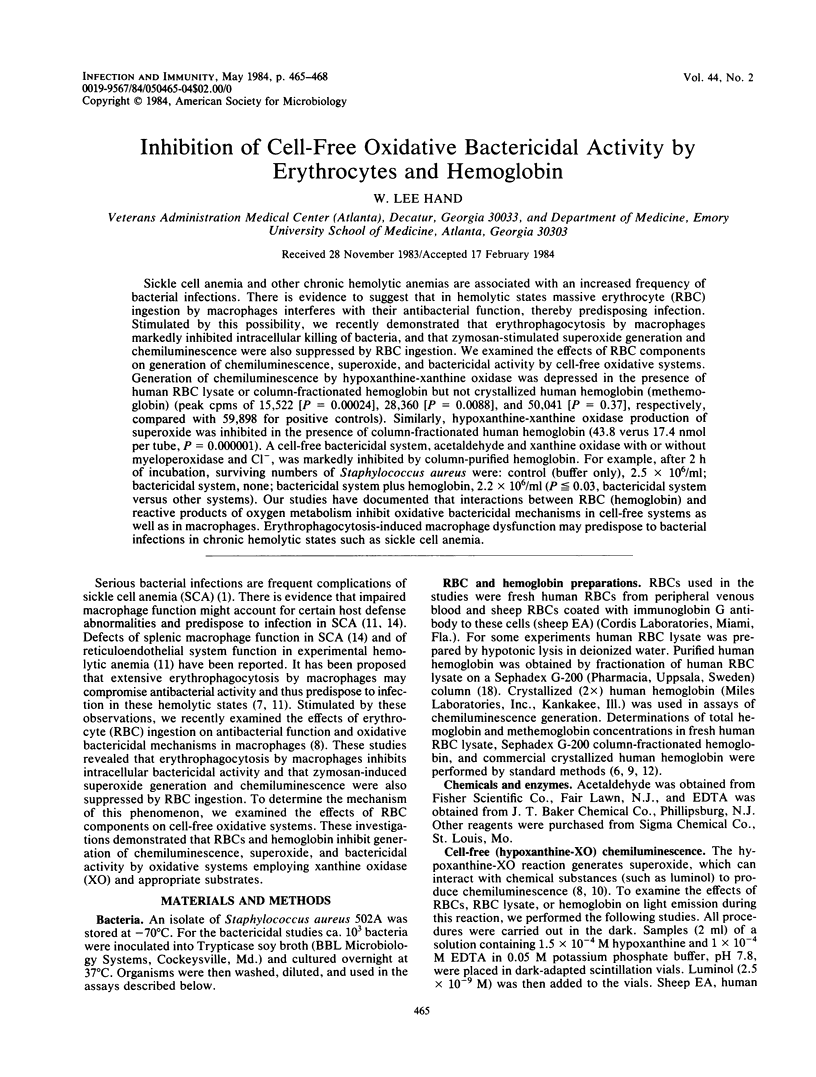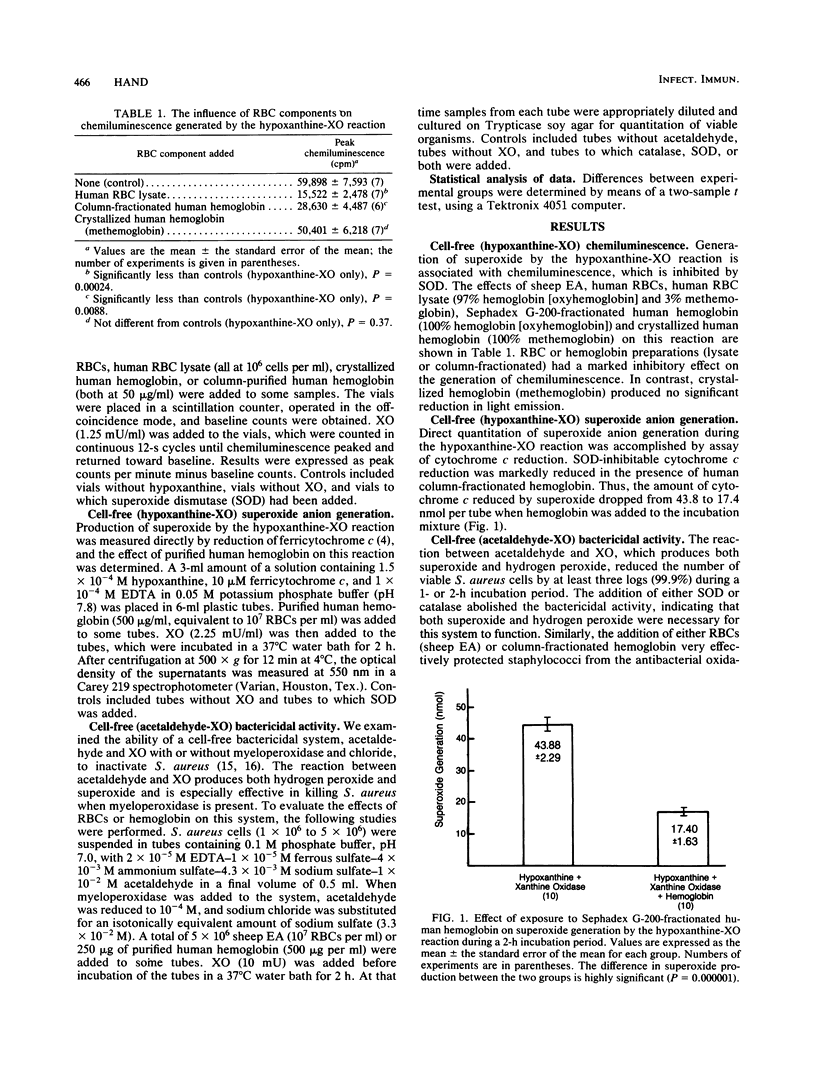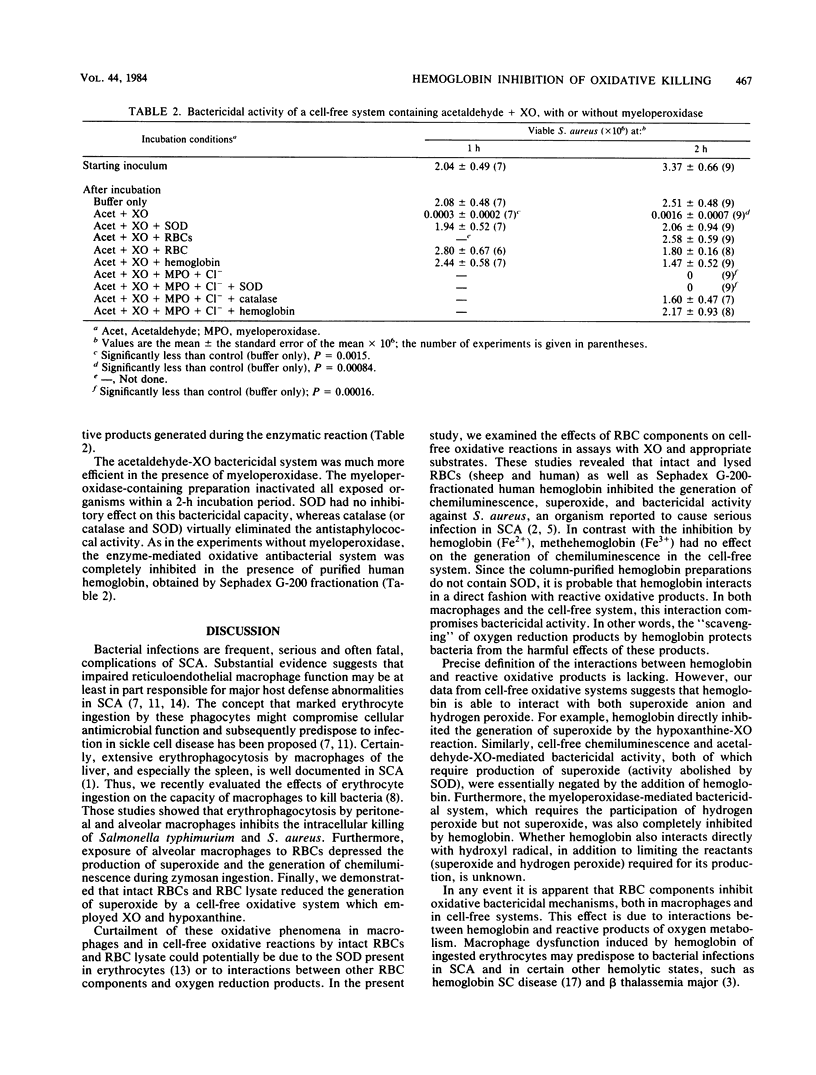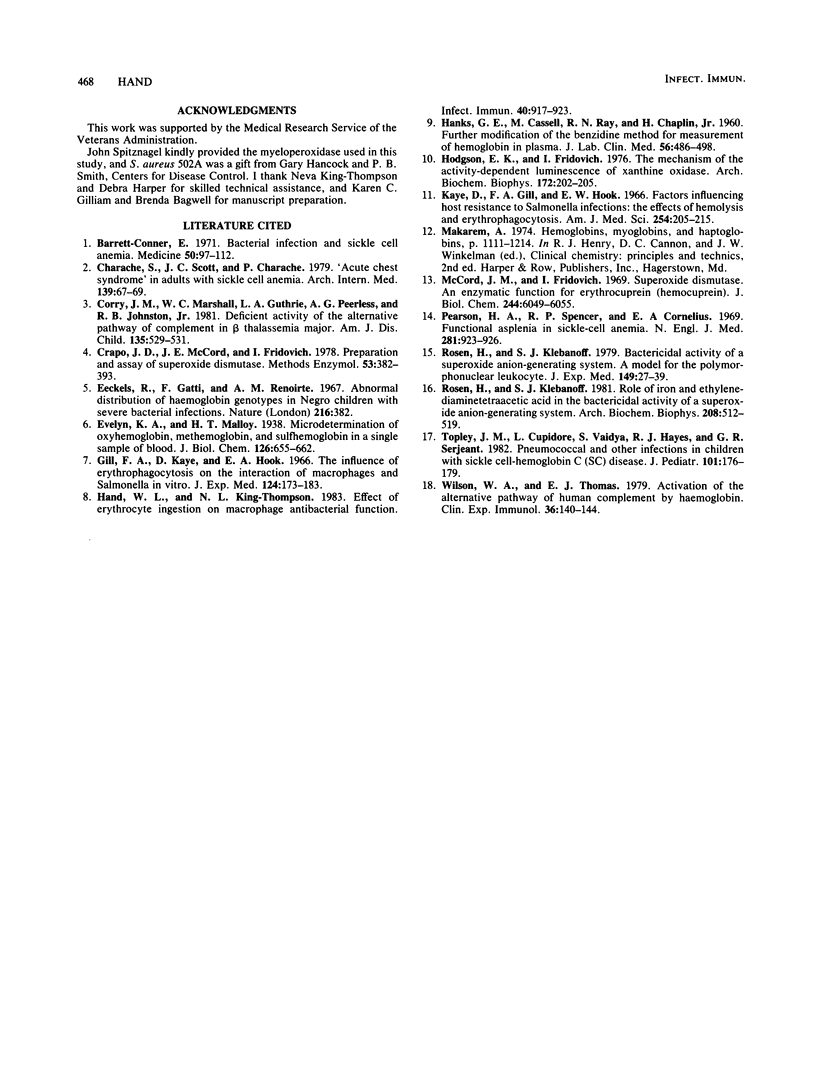Abstract
Sickle cell anemia and other chronic hemolytic anemias are associated with an increased frequency of bacterial infections. There is evidence to suggest that in hemolytic states massive erythrocyte (RBC) ingestion by macrophages interferes with their antibacterial function, thereby predisposing infection. Stimulated by this possibility, we recently demonstrated that erythrophagocytosis by macrophages markedly inhibited intracellular killing of bacteria, and that zymosan-stimulated superoxide generation and chemiluminescence were also suppressed by RBC ingestion. We examined the effects of RBC components on generation of chemiluminescence, superoxide, and bactericidal activity by cell-free oxidative systems. Generation of chemiluminescence by hypoxanthine-xanthine oxidase was depressed in the presence of human RBC lysate or column-fractionated hemoglobin but not crystallized human hemoglobin (methemoglobin) (peak cpms of 15,522 [P = 0.00024], 28,360 [P = 0.0088], and 50,041 [P = 0.37], respectively, compared with 59,898 for positive controls). Similarly, hypoxanthine-xanthine oxidase production of superoxide was inhibited in the presence of column-fractionated human hemoglobin (43.8 versus 17.4 nmol per tube, P = 0.000001). A cell-free bactericidal system, acetaldehyde and xanthine oxidase with or without myeloperoxidase and Cl-, was markedly inhibited by column-purified hemoglobin. For example, after 2 h of incubation, surviving numbers of Staphylococcus aureus were: control (buffer only), 2.5 X 10(6)/ml; bactericidal system, none; bactericidal system plus hemoglobin, 2.2 X 10(6)/ml (P less than or equal to 0.03, bactericidal system versus other systems). Our studies have documented that interactions between RBC (hemoglobin) and reactive products of oxygen metabolism inhibit oxidative bactericidal mechanisms in cell-free systems as well as in macrophages.(ABSTRACT TRUNCATED AT 250 WORDS)
Full text
PDF



Selected References
These references are in PubMed. This may not be the complete list of references from this article.
- Barrett-Connor E. Bacterial infection and sickle cell anemia. An analysis of 250 infections in 166 patients and a review of the literature. Medicine (Baltimore) 1971 Mar;50(2):97–112. [PubMed] [Google Scholar]
- Charache S., Scott J. C., Charache P. "Acute chest syndrome" in adults with sickle cell anemia. Microbiology, treatment, and prevention. Arch Intern Med. 1979 Jan;139(1):67–69. [PubMed] [Google Scholar]
- Corry J. M., Marshall W. C., Guthrie L. A., Peerless A. G., Johnston R. B., Jr Deficient activity of the alternative pathway of complement in beta thalassemia major. Am J Dis Child. 1981 Jun;135(6):529–531. doi: 10.1001/archpedi.1981.02130300029011. [DOI] [PubMed] [Google Scholar]
- Crapo J. D., McCord J. M., Fridovich I. Preparation and assay of superoxide dismutases. Methods Enzymol. 1978;53:382–393. doi: 10.1016/s0076-6879(78)53044-9. [DOI] [PubMed] [Google Scholar]
- Eeckels R., Gatti F., Renoirte A. M. Abnormal distribution of haemoglobin genotypes in Negro children with severe bacterial infections. Nature. 1967 Oct 28;216(5113):382–382. doi: 10.1038/216382a0. [DOI] [PubMed] [Google Scholar]
- Gill F. A., Kaye D., Hook E. W. The influence of erythrophagocytosis on the interaction of macrophages and salmonella in vitro. J Exp Med. 1966 Aug 1;124(2):173–183. doi: 10.1084/jem.124.2.173. [DOI] [PMC free article] [PubMed] [Google Scholar]
- HANKS G. E., CASSELL M., RAY R. N., CHAPLIN H., Jr Further modification of the benzidine method for measurement of hemoglobin in plasma; definitionn of a new range of normal values. J Lab Clin Med. 1960 Sep;56:486–498. [PubMed] [Google Scholar]
- Hand W. L., King-Thompson N. L. Effect of erythrocyte ingestion on macrophage antibacterial function. Infect Immun. 1983 Jun;40(3):917–923. doi: 10.1128/iai.40.3.917-923.1983. [DOI] [PMC free article] [PubMed] [Google Scholar]
- Hodgson E. K., Fridovich I. The mechanism of the activity-dependent luminescence of xanthine oxidase. Arch Biochem Biophys. 1976 Jan;172(1):202–205. doi: 10.1016/0003-9861(76)90067-9. [DOI] [PubMed] [Google Scholar]
- Kaye D., Gill F. A., Hook E. W. Factors influencing host resistance to Salmonella infections: the effects of hemolysis and erythrophagocytosis. Am J Med Sci. 1967 Aug;254(2):205–215. doi: 10.1097/00000441-196708000-00011. [DOI] [PubMed] [Google Scholar]
- McCord J. M., Fridovich I. Superoxide dismutase. An enzymic function for erythrocuprein (hemocuprein). J Biol Chem. 1969 Nov 25;244(22):6049–6055. [PubMed] [Google Scholar]
- Pearson H. A., Spencer R. P., Cornelius E. A. Functional asplenia in sickle-cell anemia. N Engl J Med. 1969 Oct 23;281(17):923–926. doi: 10.1056/NEJM196910232811703. [DOI] [PubMed] [Google Scholar]
- Rosen H., Klebanoff S. J. Bactericidal activity of a superoxide anion-generating system. A model for the polymorphonuclear leukocyte. J Exp Med. 1979 Jan 1;149(1):27–39. doi: 10.1084/jem.149.1.27. [DOI] [PMC free article] [PubMed] [Google Scholar]
- Rosen H., Klebanoff S. J. Role of iron and ethylenediaminetetraacetic acid in the bactericidal activity of a superoxide anion-generating system. Arch Biochem Biophys. 1981 May;208(2):512–519. doi: 10.1016/0003-9861(81)90539-7. [DOI] [PubMed] [Google Scholar]
- Topley J. M., Cupidore L., Vaidya S., Hayes R. J., Serjeant G. R. Pneumococcal and other infections in children with sickle-cell hemoglobin C (SC) disease. J Pediatr. 1982 Aug;101(2):176–179. doi: 10.1016/s0022-3476(82)80112-1. [DOI] [PubMed] [Google Scholar]
- Wilson W. A., Thomas E. J. Activation of the alternative pathway of human complement by haemoglobin. Clin Exp Immunol. 1979 Apr;36(1):140–144. [PMC free article] [PubMed] [Google Scholar]


